Maurice Ravel
With an explanation of why what seems to be the easiest orchestral composition to play is really one of the most difficult to the extent it has become a requisite for auditions in major symphony orchestras with an added discussion on selecting alternate tempos even when the composer states what the tempo should be.
It's easy these days to think of Maurice Ravel as a one-hit wonder. His repetitive composition Boléro is a tune that everyone recognizes and is in the repertoire of virtually all orchestras. It was an instant classic and was used in film scores starting with George Raft's Boléro in 1934 where George and Carole Lombard dance to the tune.1 But ask Joe and Josephine Blow on the street to name another piece by Maurice and they'll be stumped.
Footnote
The movie was a rather strange way to praise the composition since as soon as George's character finishes the dance he drops dead.
The continuing popularity of the music presents no mystery. Unlike much - quote - "modern music" - unquote - that began appearing in the early 20th century, Boléro has a nice sedate tune with no discordant atonal harmonies2 or erratic melodies whose notes seem to have been picked by a random number generator. It's also not that lengthy, typically between 14 and 15 minutes, and so it's not like sitting through the The Ring of the Nibelung.
But most of all, even though the two-themed melody repeats itself, the manner in which Maurice selected the individual instruments and sections to build toward a crashing finale ensures that the piece is never boring.
Boléro is classified as an impressionistic composition. That is - and we quote a popular dictionary - "a style of musical composition designed to create subtle moods and impressions". Obviously the name was borrowed from the painting movement of the same name which by the turn of the Millennium was no longer shocking either to the public or the critics.
Joseph Maurice Ravel was born on March 7, 1875 and so was a contemporary of Edward Steichen, Everett Shinn, William Glackens, and Maxfield Parrish, whoever they were. His mom and dad encouraged his interest in music and by the time Maurice graduated from the Paris Conservatoire, people were perfectly content with art that looked like paint splatters, sculpture that looked like restroom fixtures, and music that didn't adhere to traditional forms.
Boléro was one of Maurice's later works, and the piece had been a hit when introduced in Europe in 1928. But it really got its kick-start toward iconicity in 1929 with the 
 premiere conducted by Arturo Toscanini. At the time Arturo was the biggest name in conducting and when Arturo Toscanini conducted, people listened.
premiere conducted by Arturo Toscanini. At the time Arturo was the biggest name in conducting and when Arturo Toscanini conducted, people listened.
Arturo Toscanini
He boosted the tempo.
Of course, everyone also knows that Arturo boosted up the tempo beyond Maurice's pleasure. Maurice seemed to think that a tempo around = 66 was optimum.3 And in the famous 1930 recording where most critics believe that Maurice himself held the baton, the tempo was even a smidgen slower at
= 65 - certainly within an acceptable margin of error with his recommendation.
Footnote
For those not of the musical cognoscenti, = 66 is the metronome marking that means the conductor's beat is 66 beats per minute and the quarter note gets the beat. Or more accurately, the composition is to be conducted where there are 66 quarter notes per minute. What constitutes a beat is actually up to the conductor. For instance, in really fast tunes, like Dmitri Kabalevsky's Colas Bregnon Overture, a conductor may conduct 2 quarter notes a beat - a whole measure.
Maurice was in Europe when Arturo conducted the American premiere, but he soon learned that Arturo had sped the tune up. Then when Arturo conducted a performance in Europe, Maurice was in the audience. After the show, Maurice walked up. "A minute and a half too fast", he said, turned on his heel, and walked out. At least that's the story.
There's no recordings of Arturo's premiere, but his later recordings show that he is definitely faster than Maurice. When conducting the NBC Symphony in 1939 Arturo leads at = 72-73. The whole tune lasted 14 minutes. So if that's a minute and a half too fast, Maurice's preference would be 15 minutes and 30 seconds. And that is indeed
= 66.4
Footnote
You'll read on various popular informational websites, that Maurice originally set the tempo at = 76 and then marked out the marking and substituted
= 66. However a look at a reproduction of the first page of the actual manuscript sure seems to show the
= 76 time without any emendation.
We see, then, that Maurice clearly practiced what he preached and wanted others to follow his lead. The first recording of the song was of the Grand Orchestre Symphonique du Gramophone conducted by Piero Coppola in January 1930. Piero would surely have consulted with Maurice and Piero's tempo was even a bit slower, timing in at = 64. On the other hand, both Maurice and Piero interpreted the piece as less legato than typical today, and some notes were on the staccato side.5
Footnote
That reminds of us of the old Paul Lynde joke from Hollywood Squares. The host Peter Marshall asked Paul "Where do you find 'staccato' and 'legato'?"
Paul answered, "The police are dragging Lake Michigan right now."
But not all a-tempo interpretations are necessarily a preference of a conductor flouting Maurice's will. Sometimes unwanted circumstances dictate a hasty beat.
Lenny
Not really his fault.
For instance, in his concerts Leonard Bernstein tended to conduct the tune at around = 71-72. In two performances separated by almost twenty years this was his unwavering tempo and a sampling of modern performances shows
= 70-72 is common with today's conductors.
But in a Young People's Concert in 1958, Lenny conducted the piece at a frantic = 82 and raced through the song in 12 minutes and 40 seconds - not quite the fastest on record but pretty darn close. However, we can't fault him for what would have surely sent Maurice into fits of conniption. Instead Lenny was clearly under time pressure as he was coming to the end of the show. Although he managed to finish up in time, they were putting up the final credits on the screen even before the finale.
But if you do want the fastest rendering you should turn to Leopold Stokowski conducting the American Youth Orchestra in 1940. A timing of this puts it at 12 minutes flat or a near blistering = 85. And it seems that Leopold even sped up a bit as he moved along.
OK. Just how long should Boléro take? Well, if you want to plan the time exactly you need to know how many beats there are in the entire piece and fit the tempo accordingly.
Exactly how many beats are in the tune isn't something you find in your typical encyclopedia and one reference which does report the number of measures appears to have transposed two numbers so that if the performance takes 15 minutes the tempo would be something like = 86. Not something Maurice would like.
Now there have been many editions of the song. But they do tend to be a bit pricey - a couple of hundred US dollars isn't unusual - so if you don't want to shuck out of that type of dough, there is one alternate tack.
There are still these buildings called libraries. And believe it or not, you can walk into these buildings and find those non-electronic devices with white flappy things in the middle called books. You can often borrow these books for a couple of weeks and for free. And among these books you'll find a lot of music.
But it's a good bet that if you go into one of these libraries you won't find Boléro. But the librarians - often nice helpful ladies - ought to be able to get you what is called an inter-library loan where the rarity of the book and lack of access probably won't matter. And so if you want to determine the duration of Boléro and how it correlates with the tempo there is no hinderence for the diligent student.
And lo!, a counting of the measures reveals a nice round 340. So at 3/4 time, that's 1017 beats.6 So now putting the variables in a nice neat table we find:
Footnote
The last measure has only a single eighth-note. So the last two beats don't count.
Bolero et Le Tempo7
| Metronome ( | Total Time (Min Sec) | Advocates |
| 55 | 18' 30" | Somnambulists |
| 60 | 16' 57" | The Lackadaisical |
| 65-66 | 15' 30" | Maurice Hisself |
| 71 | 14' 20" | Lenny |
| 72-73 | 14' 0" | Arturo |
| 82 | 12' 24" | Lenny (When Pressed) |
| 85 | 12' 0" | Leopold! Leopold! |
*beats per minute
Footnote
Differences between the metronome marking and total time may reflect round off errors or variable tempos within a single performance. But they're pretty close.
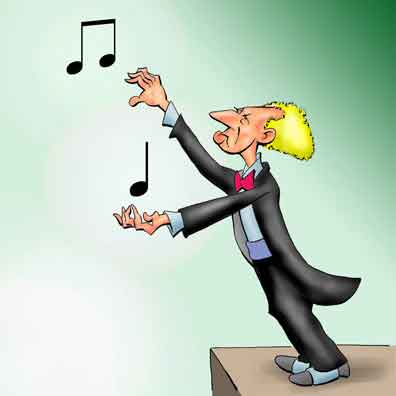
Leopold! Leopold!
The two early recordings of Piero and Maurice sound a bit odd to modern ears. Not only did the orchestra play slower and with less legato, but both men went in for a bit more jazzy effects. Certainly the trombone soloist played the glissandi in a souped up style you don't hear today. But then in 1928 jazz was the big thing. And unlike Dmitri Shostakovich, whose Jazz Suites although quite catchy ain't remotely jazz, Maurice had first hand experience with the genre. On a tour of America, Maurice had visited some of Harlem's nightspots and had even taken in some Dixieland in New Orleans.
With Boléro's easy pace and fairly simple melody, one thing that Joe and Josephine Blow on the street don't realize is that the parts can be quite taxing for the instrumentalists. The trombone solo in Bolero is one of the most demanding in the instrument's repertoire, and if you audition for a trombone desk for a major symphony orchestra, you'll be expected to play it. If you can't do that, you won't get the job.
But even though the solo is a standard audition piece, part of the fun of attending a live performance is to see if the trombone player makes a hash of it.
And we're not just talking about playing with lack of expressions or without "feeling". Nor are we referring to anything as extreme as what's called the "Trombone Bolero Disaster" where the trombonist in the as yet to be identified orchestra had a complete meltdown and where a second player had to take over.
No, instead we're talking about live performances by major symphony orchestras staffed with elite musicians. You'll even hear flubs amongst the "Big Five".8
Footnote
That's, the New York Philharmonic, the Boston Symphony, the Chicago Symphony, the Philadelphia Orchestra, and the Cleveland Orchestra.
At this point, though, the trombone players will wax wroth9 and point out that the trombone section sits through the first half of the piece - about 7 minutes - without playing at all. So the soloist has to come in "cold" on the high B-flat which is four lines above the bass clef staff (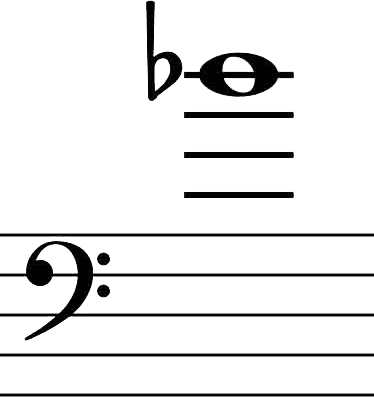 ) - what eggheads call B4-♭. Then the player moves up to the high D-flat (
) - what eggheads call B4-♭. Then the player moves up to the high D-flat (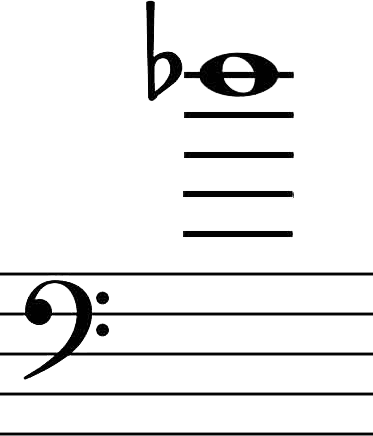 , D5-♭). In this place the harmonic series of the instrument are only a step apart. So there's three places - the initial B-flat, the transitory C, and the high D-flat - where it's particularly easy to burble the notes.
, D5-♭). In this place the harmonic series of the instrument are only a step apart. So there's three places - the initial B-flat, the transitory C, and the high D-flat - where it's particularly easy to burble the notes.
And if that's not enough of a problem, Maurice has all the trombones play the same part again later in the piece. Not just once but twice! Talk about busting your chops!
But now as always we have the curmudgeons step in! What's the problem, they ask, with hitting a B-flat on a B-flat trombone? Seems nothing could be simpler. And the D-flat? That's only a minor third higher up.
Well, for one thing, the trombonists explain with patience, the high B-flat is the highest note in traditional trombone pedagogy, and you'll see this limit in instruction manuals. So the player has to start out on the - quote - "highest note" - unquote - and then play even higher to reach the D-flat.
And don't forget there was a time the high B-flat was the limit for even virtuoso players. In 1878 in Kronstadt, Russia, Nikolai Rimsky-Korsakov's premiered his popular but (let's admit it) overrated "Concerto for Trombone and Military Band". Although in the cadenzas some modern editions go up to über high F (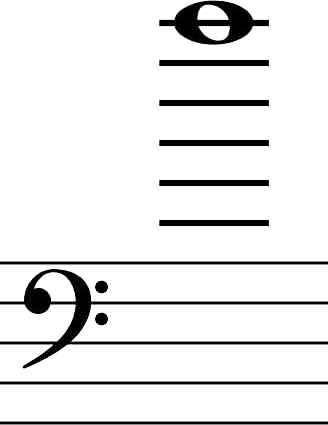 ) the original score has no note above the traditional "high" B-flat (
) the original score has no note above the traditional "high" B-flat ( ).
).
So wearily shaking their heads, the trombonists lament the difficulties of the part. Oh, for the ease of the woodwinds who can avoid problems of the high range harmonic series just by pressing an octave key!
Ha? the woodwindists say, quoting Shakespeare. Just by pressing an octave key?
We hate to tell you, Mr. Brass Player, they say, but claiming that woodwinds have different fingerings for each note and so avoid harmonic series problems, that is to laugh. All woodwind instruments have harmonic series where different notes can be played with the same fingerings. "Overblowing" - changing the speed (or more accurately, the pressure) of the air flow - can jump a note a specific interval, often, but not always, an octave. In fact some instruments, like the flute, require overblowing to play in the upper registers.
The bassoonists in particular take much exception to the "just press the octave key" schtick since their instrument doesn't have an octave key. In fact, they have an anti- octave key - called the "whisper" key - to help play in the lower register.
Instead Bolero's bassoon solo is every bit as taxing as that of the trombone and is also a required audition piece for players in major symphony orchestras. In fact, the bassoon solo has exactly the same notes - even in absolute pitch. The bassoonist starts on the high B-flat and goes up to the D-flat. Hitting the high notes dead on is particularly a challenge on a bassoon and you can fluff a note with great élan.
Besides bassoonists have difficulties that the trombonists can't even imagine! The bassoon is not only one of the most complicated instruments in the modern orchestra - the left thumb alone has to control 9 keys (or is it 10?) - but it's one of the most difficult to play in tune. Even with the best modern instruments this is a truly Herculean task and some notes still require "half-holing" - an early technique that most woodwinds no longer need.
Trombonists, on the other hand, have probably the simplest instrument in construction, the triangle excepted. And they have a tuning slide in their hands at all times! So the trombones should easily play with the best intonation in the orchestra.
As far as hitting the note right on, the bassoon requires some keys to be "flicked" to avoid inadvertent multiphonics - the rather rough sounding playing of simultaneous pitches. Flicking requires a key to be pressed briefly at the beginning of the note and then quickly released.
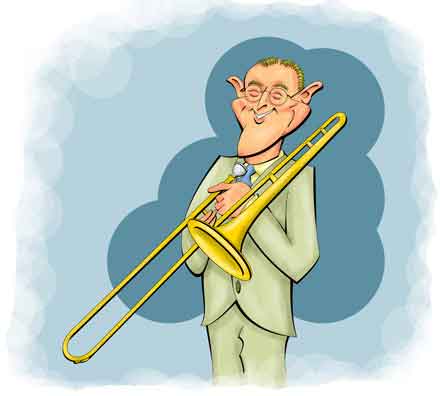
Tommy Dorsey
He hit the D-flat/C-sharp.
Besides, the bassoonists say, what's the big deal with the high B-flat to D-flat for a trombone professional? C'mon, Tommy Dorsey was playing a routine high D-flat in "I'm Getting Sentimental Over You" in 1932 although he wrote it as a C-sharp. So it's clear that in the 20th century it was expected that a top flight trombonist should find playing the high D-flat/C-sharp pretty pud.
Whaddaya mean, what's the deal? the trombonists counter. There's the sheer physical effort of reaching the high notes on a brass instrument. It takes muscles to play that high. And you have to play a real note, not just a pinched-lipped squeal.
In any case Tommy didn't sit silent for seven minutes and hit the note cold. He started off a full octave lower and then moved on up to F4-♯ and A4, before playing the high C5-♯.
What a hoot!, the bassoonists say. Why, the trombonists should just take their slides and ...
Well, at this point perhaps we should pause for the sake of decorum. It's unlikely there will be any quick resolution to the great trombone/bassoon debate. We'll just agree that Boléro is one of the more deceptively difficult compositions in the modern repertory. And that applies to other instruments as well.
Much has been written about what prompted Maurice to write the song which has only a single two-themed melody and no tempo variation. For some reason, it's doesn't do to simply say that Maurice was an innovated and talented composer. No, some medical professionals like to suggest it might have been due to a neurological problem that ultimately led to a doctor removing a bit of Maurice's skull (a procedure called a craniotomy).
And indeed in October 1932 Maurice had taken a taxi from the theater and on the way back to his apartment it hit another car. Maurice was thrown forward and hit his head against the windshield. Two of the cuts required stitches and there was suggestion of internal injuries to his chest.
Despite some claims it was a minor accident, it's been suggested that the injuries resulted in progressive aphasia, a condition, which ultimately impairs mental functions. Some time after the accident Maurice did begin having problems with his memory, trouble with names, and found it increasingly difficult to write. Of course, it was hard for him to compose. But he was aware of his condition which made it even more difficult since the doctors couldn't even decide what was the matter.
There was finally an operation to determine if there was a tumor. Some who knew Maurice said the operation was against his will but others say it was with his consent. The operation was on December 17, 1937 and the findings were negative. Although Maurice regained consciousness afterwards he soon fell into a coma and died on December 28. There was a further complication because undertakers were on strike and government intervention was needed before Maurice could be buried.
It's hard to see how any of this had anything to do with Boléro. The accident happened in 1932 and Boléro was written in 1928. True, it's been suggested that the accident exacerbated a pre-existing condition but this seems to be one of those after-the-fact and long range diagnoses which are so easy to do and so difficult to prove. On the other hand, in the late 1920's no one seemed to notice anything amiss with Maurice.
For his part Maurice said the composition was simply an experiment. That may be but if so it was actually a commissioned experiment and was written for the dancer, Ida Rubenstein. Ida wanted a ballet and the usual idea is the choreography is that a lady is dancing in a tavern and she gets wilder and wilder until she's overcome and collapses from her exertions. The first performance in 1928 was as a ballet, but the song quickly turned into the concert hall staple we know today.
But Maurice's fans will pooh-pooh the notion that Maurice is a one-hit wonder, and he found success well before Bolero, particularly with his ballet, Daphnis and Chloe. This hit was preceded by Pavane Pour Une Infante Défunte and Rapsodie Espagnole and followed by Piano Concerto In G Major and Jeux d'Eau. And remember that one of his most popular contributions to the concert hall remains his orchestration of Modest Mussorgsky Pictures at an Exhbiiton. Modest, of course, was Mr. Mussorgsky's name, not a self-opinion of his abilities.
References
Ravel, Roger Nichols, Yale University Press, 2011.
Ravel’s Boléro, Janet Horvath, Interlude, May 8, 2013.
"Ballet Beneath the Morgan", Madison Schindele, The Morgan Library and Museum, Friday, 10/08/2021.
Ravel: Boléro, La Valse, Rapsodie espagnole and Alborada del gracioso, Leonard Bernstein (Conductor), New York Philharmonic (Orchestra), Sony, 1958.
"Ravel's Boléro, A Complete Guide To The Best Recordings", Philip Clark, Gramophone, May 25, 2021.
Boléro, Piero Coppola and the Grand Orchestre Symphonique du Gramophone, Polydor, January 13, 1930 (Recording).
"Maurice Ravel's Illness: A Tragedy of Lost Creativity", R. A. Henson, British Medical Journal, 1988, 296(6636): 1585-1588.
"What is Orchestration?", Leonard Bernstein (Conductor), New York Philharmonic (Orchestra), Young People's Concerts, March 8, 1958, CBS.
Leonard Bernstein's Young People's Concerts, Leonard Bernstein, Anchor Books, 1991.
"Bassoon Finger Chart", Musical Instrument Guide, Yamaha.
"The Not-Quite-Harmonic Overblowing of the Bassoon", James B. Kopp, Kopp Reeds.
"A Guide To Playing the Horrendous Snare Drum Part in Ravel's 'Bolero'", Classic FM, January 13, 2016.
Symphony 9 (Dvorak) / Symphony 7 (Sibelius) / Bolero (Ravel), Leopold Stokowski (Conductor), American Youth Orchestra (Performers), Music and Arts Program, 2006 (Re-issue of 1940 Album).